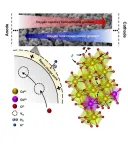(Press-News.org) UNIVERSITY PARK, Pa. — Each year between 200,000 and 270,000 children and youth enter foster care placements with child welfare services, and many more children receive child welfare services while remaining in their parent's care, according to the U.S. Department of Health and Human Services. Although many of these children have a documented history of abuse or neglect, children may respond differently to incidents of maltreatment or other potentially traumatic events. Incorporating a trauma screening — which assesses how trauma and maltreatment affected each child — into the child welfare evaluation process provides information that could be used to connect children to the specific mental-health services they need, according to new research from the Penn State College of Health and Human Development and the Child Health and Development Institute.
Individuals react differently to traumatic events like stress or abuse. Some children develop signs of traumatic stress while other people in similar situations do not. For children who experience distress, some become hypervigilant, and others may become withdrawn.
Christian Connell, associate professor of human development and family studies and director of the Child Maltreatment Solutions Network, and collaborator, Jason Lang, chief program officer at the Child Health and Development Institute and a faculty member in the Yale School of Medicine and University of Connecticut, led a study on the value of screening for traumatic experiences during child welfare system intake evaluations. Their study demonstrated that asking a small number of questions about trauma during these evaluations led to better identification of trauma symptoms and more appropriate trauma-focused service recommendations for children. Results of the study were recently published in Journal of Traumatic Stress.
In 2014, Connell and Lang created the Child Trauma Screen, a 10-item screening questionnaire that measures trauma exposure and symptoms of post-traumatic stress disorder in children. The screen was designed for use with established child welfare service evaluations and is freely available to any government entity or child-serving service organization that wishes to use it. Since 2015, the state of Connecticut has included the Child Trauma Screen as part of evaluations for children placed in the child welfare system.
In this study, the researchers reviewed Connecticut child welfare records from July 2013 through October 2014, before the screening was implemented, and from October 2015 through March 2016, after the screening was integrated into evaluations across the state. The research team examined 70 records from the pre-screening time period and 100 records from the screening time period for children between the ages of six and 17.
“When a child encounters the child welfare system, he or she may have had a number of difficult life experiences. The Child Trauma Screen helps staff understand how the system might best respond to that child’s needs related to these experiences,” said Connell, who is also one of the principal investigators of the Translational Center for Child Maltreatment Studies, within the Penn State Center for Safe and Healthy Children. “While the child welfare investigation processes usually identifies the types of experiences the child may have had leading to child welfare involvement, staff also need a standard way to assess how the child is processing those experiences to better identify appropriate service referrals. This is why we created the Child Trauma Screen.”
By using the Child Trauma Screen when children entered formal involvement with the child welfare system, case workers were able to gather consistent information on the types of traumatic stress reactions experienced by children. Results from the study showed that using the screening led to better documentation of children’s reactions to traumatic events and increased service recommendations and referrals for specific, trauma-focused services.
One potential concern arises from the fact that — despite the heightened rates of referral for services prompted by the trauma screening — the results did not demonstrate a corresponding increase in children receiving trauma-related services. The data in this study do not explain why the recommendations did not lead to more services being documented in the child welfare record, but the researchers agreed that identifying that disconnect is critically important so that they can understand and rectify it. Potential explanations include challenges in accessing services within communities or a failure to document services that were provided.
“Ultimately, the goal is to connect children who have experienced trauma to the services and supports they need,” Connell said. “Our results show that screening can be an important part of that process, but that further work is required to make the connection. The next step is identifying the barriers to providing trauma-related services and then connecting each child with the specific help they need.”
The Child Trauma Screen has been translated into several languages and is used by juvenile courts and child welfare systems in multiple states and localities in the U.S. and internationally. Connell and Lang said that there are multiple valid tools that can be used for trauma screening, but the most important thing is that children should be screened for trauma experiences and trauma-related symptoms if there in an opportunity to connect them with necessary services.
“Most children who suffer from traumatic stress do not receive behavioral health services, and some suffer in silence alone without telling anybody what they experienced,” Lang said. “Screening is an effective strategy for identifying children who are suffering and providing support and connection with behavioral health or other services. Unfortunately, trauma screening is not commonly used in many settings where it can be helpful, so we are also creating trainings for adults who work with children.”
The Child Health and Development Institute is developing a web-based training program about trauma screening for social workers, health care providers, educators and other people who work with children. Trauma ScreenTIME is a five-module, web-based training on trauma screening developed with funding from the Substance Abuse and Mental Health Services Administration’s National Child Traumatic Stress Network. So far, over 1,600 people have enrolled and more than 500 have completed the training, according to Connell, who is evaluating the effects of the training among participants.
Modules for people who work in schools and pediatric medical care are available now, and modules for people who work in early childcare, child welfare and juvenile justice are in development. Like the Child Trauma Screen, the Trauma ScreenTime trainings are available for free online.
“Many child-serving professionals are reluctant or don’t feel equipped to talk with children and families about trauma,” Lang said. “Trauma ScreenTIME provides comprehensive courses in trauma-screening best practices. The trainings address common questions and concerns and provide simple strategies that can be used in virtually any child-serving setting.”
Ann Shun Swanson, graduate student at Penn State, and Maegan Genovese, research associate at The Consultation Center in the Yale School of Medicine, also contributed to this research.
The United States Department of Health and Human Services, Administration for Children and Families and the Children’s Bureau funded this project.
END
Trauma screening may improve mental health service recommendations for children
2024-03-11
ELSE PRESS RELEASES FROM THIS DATE:
Wrist device that monitors activity could help provide early warning of Alzheimer’s
2024-03-11
Monitoring daily activity patterns using a wrist-worn device may detect early warning signs of Alzheimer’s disease, according to a new study led by researchers at the Johns Hopkins Bloomberg School of Public Health.
The researchers analyzed movement data from wristwatch-like devices called actigraphs worn by 82 cognitively healthy older adults who were participants in a long-running study of aging. Some of the participants had detectable brain amyloid buildup as measured by PET scan. Buildup of the protein amyloid beta in the brain is a key feature of Alzheimer’s disease.
Using a sensitive statistical technique, the ...
Synergistic proton and oxygen-ion transport in fluorite oxide-ion conductor
2024-03-11
They published their work on new superionic mechanism in fluorite oxide electrolyte for low temperature protonic ceramic fuel cells in Energy Material Advances.
"The development of low-temperature and high-performance solid oxide fuel cells is imperative." said corresponding author Dr. Jianbing Huang, Associate Professor of the State Key Laboratory of Multiphase Flow in Power Engineering, Xi'an Jiaotong University.
Dr. Huang explained that protonic ceramic fuel cell has several significant advantages as an alternative solid oxide fuel cell ...
Complex chemistry in the cold depths of space (video)
2024-03-11
WASHINGTON, March 11, 2024 — For years, scientists thought some complex molecules could only be formed on Earth. But what if we found these kinds of molecules out in space after all? In this episode of Reactions, we explore new findings that show complex carbon ring structures can be formed in space, and what that might mean for biology, chemistry and our own chemical history! https://youtu.be/Jh_O5JP10aQ?si=HFvdSchFY95y4idV
Reactions is a video series produced by the American Chemical Society and PBS Digital Studios. Subscribe to Reactions at http://bit.ly/ACSReactions and follow us on Twitter @ACSReactions.
The ...
TaskMatrix.AI: Making big models do small jobs with APIs
2024-03-11
A research team at Microsoft has designed an efficiency tool called TaskMatrix.AI that can be used to accomplish a wide variety of specific AI tasks. TaskMatrix.AI connects general-purpose foundation models like GPT-4, the model behind ChatGPT, with specialized models suitable for certain tasks — much like a human project manager. This research was published Feb. 16 in Intelligent Computing, a Science Partner Journal.
Foundation models and specialized models usually have different mechanisms thus are not easily compatible. Rather than modifying and integrating existing models, TaskMatrix.AI bridges the gaps between them through application ...
Turns out—male roundworms are picky when choosing a mate, new research finds
2024-03-11
A piece of rotting fruit is likely covered in hundreds if not thousands of microscopic roundworms, including C. elegans—a popular experimental model system for studying neurogenetics. With a lifespan of only a few weeks, C. elegans must reproduce quickly and often. The species is made up of hermaphrodites and males. The hermaphrodites have female bodies, can self-fertilize, and can mate with males. Recent research from of the Portman Lab at the Del Monte Institute for Neuroscience at the University of Rochester, found the males do not mate indiscriminately—they are selective about things like age, mating history, and nutrition.
“We ...
Anemonefish are better taxonomists than humans
2024-03-11
Anemonefish form mutualistic relationships with the sea anemones they live in and these associations are not random: some species such as the yellow-tail anemonefish (Amphiprion clarkii) are generalists and can live in almost any sea anemone, others like the tomato clownfish (Amphiprion frenatus) are specialists, living in only one sea anemone species, the bubble-tip sea anemone (Entacmaea quadricolor). Reasons for these preferences are unclear because we know very little about the genetic diversity of giant sea anemones.
Researchers at the Marine Eco-Evo-Devo Unit and Marine Genomics Unit at the Okinawa Institute of Science ...
Social determinants of health and redirection of care for infants born extremely preterm
2024-03-11
About The Study: In this study of 15,000 infants born extremely preterm, redirection of care discussions (withdrawal, withholding, or limiting escalation of treatment) occurred less often for Black and Hispanic infants than for white and non-Hispanic infants. It is important to explore the possible reasons underlying these differences.
Authors: Jane E. Brumbaugh, M.D., of the Mayo Clinic in Rochester, Minnesota, is the corresponding author.
To access the embargoed study: Visit our For The Media website at this link https://media.jamanetwork.com/
(doi:10.1001/jamapediatrics.2024.0125)
Editor’s ...
Generative AI to transform inpatient discharge summaries to patient-friendly language and format
2024-03-11
About The Study: The findings of this study of 50 discharge summaries suggest that large language models can be used to translate discharge summaries into patient-friendly language and formats that are significantly more readable and understandable than discharge summaries as they appear in electronic health records. However, implementation will require improvements in accuracy, completeness, and safety. Given the safety concerns, initial implementation will require physician review.
Authors: Jonah ...
Permitless open carry laws may lead to more firearm-related suicides
2024-03-11
Key Takeaways
Suicide by firearm rates increased 18% in nine years in states that began allowing firearm owners to openly carry a firearm without a permit, a new study finds.
U.S. rates of firearm-related suicide rose from 21,175 in 2013 to 26,328 in 2021, an increase that may be related to more permissive open carry laws.
CHICAGO: In states that relaxed firearm laws to allow openly carrying a loaded firearm in public without a permit, significantly more people died by firearms and ...
Preventing magnet meltdowns before they can start
2024-03-11
The particle accelerators that enable high-energy physics and serve many fields of science, such as materials, medical, and fusion research, are driven by superconducting magnets that are, to put it simply, quite finicky.
Superconductors are a special class of materials which, when cooled below a certain temperature, carry large electrical currents without resistance. If you arrange the material in coils, the current passing through will produce strong magnetic fields, effectively storing the potential energy of the moving electrons in the form of magnetic field. But if they get ...





